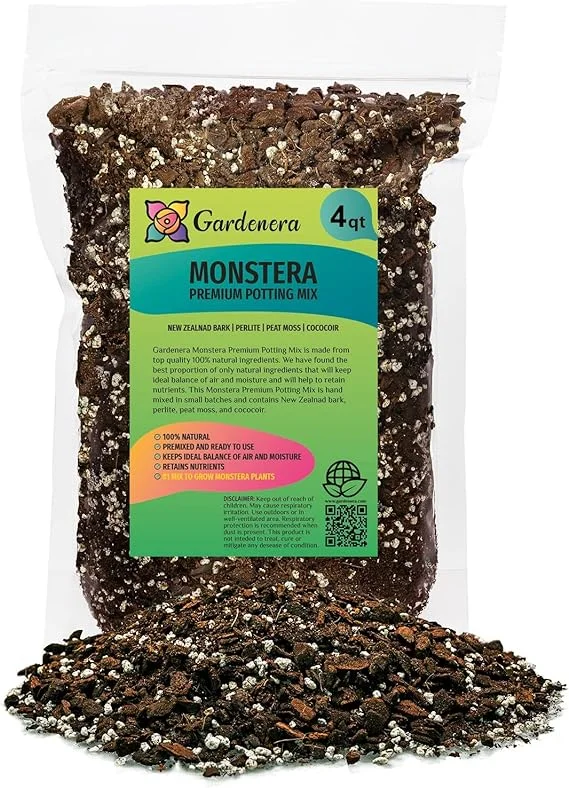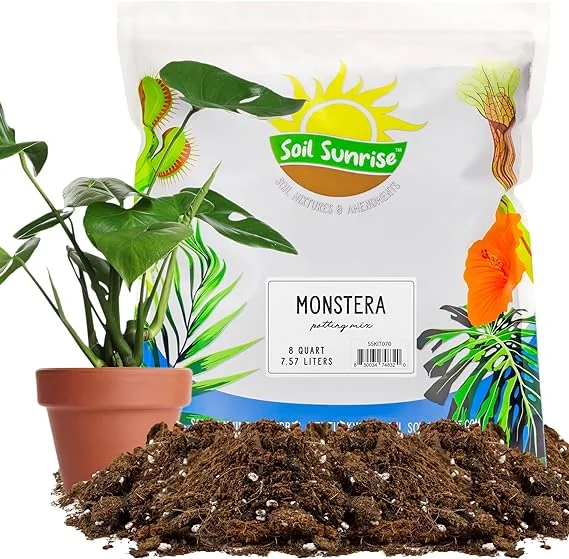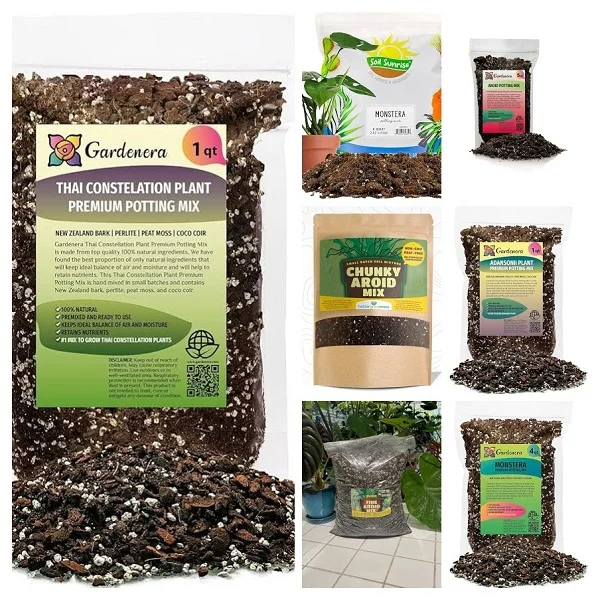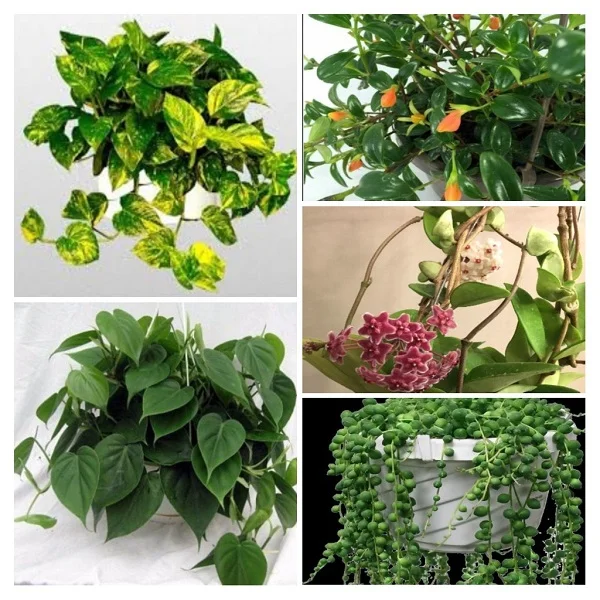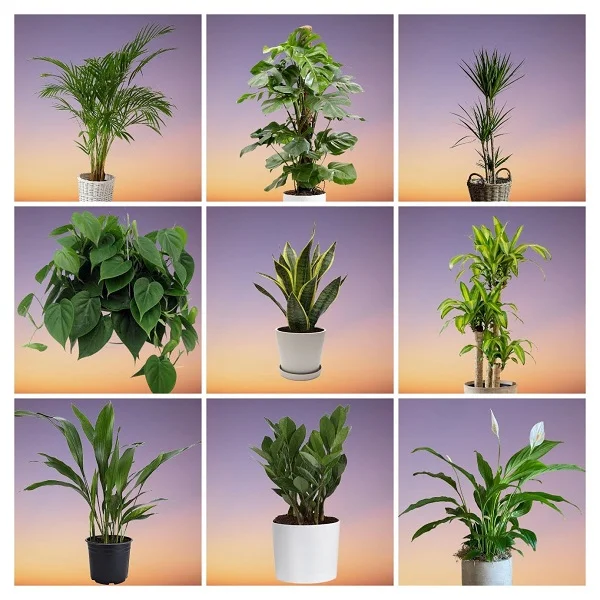Monstera adansonii (Adanson's Monstera) Care Indoors, Propagation, Problems & Remedies
Some links in this post may be affiliate links
Monstera adansonii (Adanson's Monstera) thrives in bright to medium indirect light, warm and humid conditions and moderately moist, rich, well-drained soil coupled with monthly feeding in the growing period.
Whether you are a beginner or an experienced plant enthusiast, understanding Monstera adansonii care indoors and how to address common issues will help you maintain a lush and thriving plant. This guide covers everything you need to know, from lighting and watering requirements to troubleshooting pests and diseases.
Adanson's Monstera also called Swiss Cheese Vine or Monkey Mask Plant is one of the popular Monstera varieties and bears glossy, long, ovate, green-colored, perforated leaves.
In the juvenille stage the stems exhibit a creeping habit, have short internodes while the leaves may be entire or perforated when only 5-10 cm long.
As Swiss Cheese Vine grows, it begins to exhibit climbing habits as the internodes increase in length. When provided with a moss pole, the plant grows faster with larger leaves.
Monstera adansonii has a variegated variety, Monstera adansonii 'Albo-Variegata' which bears glossy leaves with two tones of green and cream.
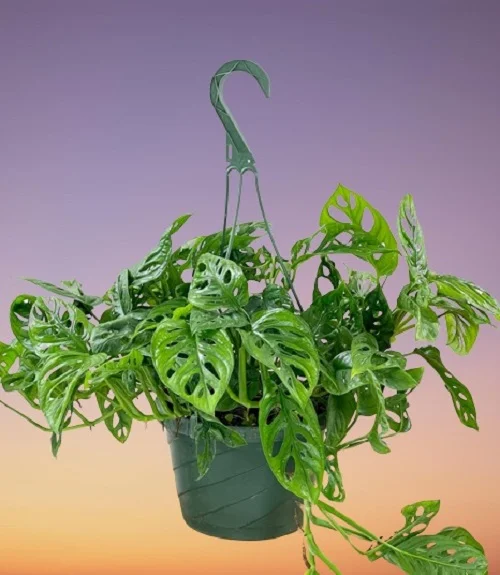
Botanical name: Monstera adansonii
Synonyms: Monstera pertusum, Philodendron pertusum
Family: Araceae
Common names: Adanson's Monstera, Swiss Cheese Vine, Monkey Mask Plant
Origin
Monstera adansonii is native to the rainforests of South America and Central America where it grows as an epiphyte on tree barks. It produces aerial roots from the stem which grasp the tree bark and other foliage to support the plant as it climbs up the tree.
Size
Adanson's Monstera is a vining plant which can grow about 13 feet long. It can be grown as a climber or in a hanging basket where the stems can hang down beautifully. Swiss Cheese Vine is among the best low-light plants for an office desk without sunlight.
Is Monstera adansonii toxic to pets?
Yes. Monstera adansonii is mildly toxic to humans and toxic to pets. As explained by ASPCA, if ingested it can cause pain and swelling in the mouth, tongue and lips, vomiting, excessive drooling and difficulty in swallowing.
Where to Buy
If you are looking to add Monstera adansonii to your collection. You may get them online from Amazon (Link to Amazon) or from Etsy (Link to Etsy).
Monstera adansonii Care Indoors
To keep Monstera adansonii happy provide bright to medium indirect light, average warmth of 17-290C, humidity of 50-55% and moderately moist, fertile, well-drained soil coupled with monthly feeding during the growing period.
Adanson's Monstera care requires regular pruning to keep it neat as well as encourage a bushy growth. Repotting is only needed when the plant becomes pot-bound. Keep reading for a detailed account on these growing conditions and how to achieve them.
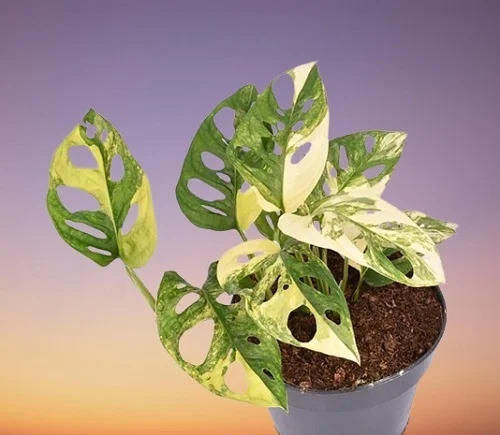
Monstera adansonii Variegata
Watering
How often should I water my Monstera adansonii indoors?
Water your Monstera adansonii liberally in spring and summer and allow the top 2-3 inches of soil to dry out between waterings. Maintain the soil moderately moist and avoid overwatering to preventing yellowing and rotting.
Cut down on watering in fall and winter to keep the soil slightly moist as growth is reduced at this time. Do not allow the soil to dry out completely to avoid wilting and leaf drop.
Avoid watering with too cold water as it can lead to shock of this tropical plant which can result in stunted growth.
Use a pot that has a drainage hole to avoid getting soggy soil as it can lead to rotting and death of the plant.
After watering, always discard any excess water from the catch plate or saucer to prevent the soil from gettting soggy.
Light Requirements
Where is the best place to put Monstera adansonii?
Monstera adansonii grows best in bright to medium indirect light. Keep it away from direct sunlight as it can cause scorching of the leaves. Position the plant next to a sunless window or near a bright window where it will receive bright to medium indirect light.
Adanson's Monstera produces small leaves and spindly leaf-stalks if there is not enough light and it stops growing in deep shade. Where the natural lighting is not adequate, you may use grow lights to supplement it.
For uniform growth and to prevent leggy growth, regularly rotate the pot to ensure that the plant receives light on all sides.
Temperature and Humidity
Monstera adansonii flourishes in an average warmth of 17-290C. Keep it away from cold drafts to avoid sudden drop in temperature as it can lead to lack of perforations in the leaves.
Adanson's Monstera has no need for high humidity. Average humidity of 50-55% is ideal for the plant. However, where the air is too dry, set the pot on a wet pebble tray or use a humidifier. Make sure that there is good air circulation to prevent fungal diseases.
Fertilizer
What kind of fertilizer for Monstera adansonii?
Feed your Monstera adansonii with a balanced, water-soluble fertilizer every 4 weeks in spring and summer for lush growth. Avoid too uch fertilizer as it can lead to leggy growth.
Withhold feeding in fall and winter as growth is reduced and feeding at this time may lead to fertilizer burn.
Regularly flush out accumulated salts from the soil by running a stream of water through the soil until it drips through the drainage hole.
Potting Soil
What is the best soil for Monstera adansonii?
The best potting soil for Monstera adansonii is a well-draining, aerated soil mix to prevent waterlogging. Potting mixes designed for Monstera and those designed for Aroids are ideal for this plant.
Repotting
Repot your Adanson's Monstera every 1-2 years during the growing season when it becomes root-bound; when roots grow through the drainage hole. Use a pot 1 size larger and one that has a drainage hole to prevent the soil from getting soggy as it can lead to root-rot.
Monstera adansonii is spectacular in a hanging basket where the stems can cascade downwards beautifully. Take a look at these hanging planters with macrame hangers on Amazon.
Pruning & Grooming
Pruning Monstera adansonii involves:
- Removal of yellow and dead leaves to maintain the plant neat as well as discourage pest and disease infestations.
- Cutting back the stems to the desired level if it becomes too large and unruly to rejuvenate growth. The stems from the pruning can be used to propagate new plants.
Regularly clean the leaves by damp-wiping with a soft cloth to get rid of dust and also discourage pest and disease infestations.
Monstera adansonii Propagation
Monstera adansonii (Adanson's Monstera) is propagated at the beginning of the growing period by use of stem cuttings or by air layering. The stem cuttings can be rooted either in soil or in water.
Propagating Adanson's Monstera from stem cuttings in soil
Take a stem cutting from a healthy plant by cutting at a point just below an aerial root. Just one leaf node with the leaf is enough to propagate a new plant.
Dip the lower cut end in a rooting hormone to hasten rooting.
Insert the cutting in moist free-draining soil. Ensure the rooting container has proper drainage to avoid getting soggy soil.
Place the set up in a warm, well-lit place away from direct sunlight.
Maintain the soil moist until new growth emerges.
Allow the new plant to be well established before transplanting after which you can begin routine care.
Propagating Adanson's Monstera from stem cuttings in water
Take a stem cutting from a healthy plant by cutting at a point just below an aerial root. Just one leaf node with the leaf is enough to propagate a new plant.
Dip the lower cut end in a rooting hormone to hasten rooting.
Place the cutting in a jar of plain water while ensuring that at least one leaf node is under water.
Position the set up in a brightly-lit spot and change the water every 5-7 days.
Once adequate roots have developed, plant the cutting in well-drained soil.
Place the set up in a warm, well-lit place away from direct sunlight.
Allow the new plant to be well established before transplanting after which you can begin routine care.
Propagating Adanson's Monstera by air layering
There are two methods of air layering Adanson's Monstera.
1. One method consists of notching the stem of a healthy Adanson's Monstera and coating the notch with a rooting hormone to encourage rooting.
Surround the notched area with damp moss and then cover it with a polythene film or clear plastic wrap.
After the roots have formed sever the stem just below the covered part.
Remove the polythene and carefully pot the rooted cutting in moist, free-draining soil.
Place in a warm, brightly-lit place and maintain the soil moist until the new plant is well established after which you can begin routine care.
2. The second way involves coating the stem at a node with a rooting hormone to promote rooting. Surround the node with damp moss and then cover it with a polythene film or clear plastic wrap.
After the roots have formed sever the stem just below the covered part.
Remove the polythene and carefully pot the rooted cutting in moist, free-draining soil.
Place in a warm, well-lit place and maintain the soil moist until the new plant is well established after which you can begin routine care.

Monstera adansonii Problems & Solutions
Monstera adansonii (Adanson's Monstera) problems are yellow leaves, lack of perforation, leaf drop, brown leaf tips and edges, leggy growth, pests and diseases among others. Keep reading for more on these problems and how to fix them.
Yellow leaves
Why are my Monstera adansonii leaves turning yellow?
Some of the causes of yellow leaves on your Monstera adansonii are inconsistent watering, soggy soil, underfeeding, and direct sunlight.
How to fix it
Inconsistent watering: Water when the top 2-3 inches of soil dry out but never allow the soil ball to dry out completely.
Soggy soil: Use a pot with a drainage hole and well-draining soil.
Underfeeding: Feed with a balanced, water-soluble fertilizer every 4 weeks in spring and summer but withhold feeding in fall and winter.
Direct sunlight: Shield the plant from direct sunshine or move it to a shadier spot.
Lack of perforation
Lack of perforation on Adanson's Monstera is due to too little light, cold drafts, lack of nutrients and underwatering.
How to fix it
Too little light: Move the plant to a brighter spot where it will receive bright indirect light or use a grow light if the natural lighting is insufficient.
Cold drafts: Keep the plant away from cold drafts to maintain an average warmth of 17-290C.
Lack of nutrients: Feed the plant with a balanced, water-soluble fertilizer every 4 weeks in the growing season.
Underwatering: Water when the top 2-3 inches of soil dry out but do not allow the soil ball to dry out completely.
Push the aerial roots into the soil or allow them to grow into a moist support to supply water and nutrients to the upper leaves.
Leaf drop
Leaf drop on Monstera adansonii is due to overwatering, temperature stress, soggy soil and aging.
How to fix it
Overwatering: Do not water on a schedule. Water when the top 2-3 inches of soil feel dry.
Temperature stress: Keep the plant away from drafts coming from AC units, heat sources, windy doors and others to maintain an average warmth of 17-290C.
Soggy soil: Use a pot with a drainage hole and well-draining soil.
Aging: As the lower leaves age, they fall as a natural process.
Brown leaf tips and edges
Brown leaf tips and edges on Adanson's Monstera are caused by low humidity and being pot-bound.
How to fix it
Low humidity: Set the pot on a wet pebble tray or use a cool mist humidifier to raise humidity.
Being pot-bound: Repot the plant into a pot 1 size larger and one with a drainage hole.
Leggy growth
Leggy growth on Monstera adansonii is due to low light and overfertilizing.
How to fix it
Low light: Position the plant in a more brighter spot or instal a grow light if the natural lighting is insufficient.
Overfertilizing: Feed monthly only in spring and summer.
Pests
Common pests in Adanson's Monstera are mealybugs, scale insects, aphids and spider mites.
How to fix it
- Isolate the affected plant to prevent spread to other plants and treat with neem oil or insecticidal soap. Make sure to follow the manufacturers instructions.
- Regularly damp-wipe the leaves with a soft cloth to discourage the pests.
- Keep the plant well pruned to minimize the hiding and breeding places for these pests.
Diseases
Monstera adansonii is prone to leaf spot disease which is brought about by overwet conditions coupled with poor air circulation. It is characterized by dark brown or black leaf spots.
How to fix it
- Isolate the affected plant to prevent spread to other plants and treat it with a fungicidal solution as indicated on the label.
- Keep the plant on the dry side, do not mist it and ensure good air circulation.
- Use a pot with a drainage hole and well-drained soil.
Conclusion
Monstera adansonii (Adanson’s Monstera), is a stunning, easy-to-care-for plant that adds tropical charm to any home. With the right light, watering, humidity, and pruning, it will thrive for years. Propagation makes it simple to expand your collection. By understanding common problems and their remedies, you can keep your plant healthy, lush, and pest-free.
You liked it? Share on social media.
Related Content
Amazon Associates Disclosure
Homeplantsguide.com is a participant in the Amazon Services LLC Associates Program, an affiliate advertising program designed to provide a means for sites to earn advertising fees by advertising and linking to amazon.com.
